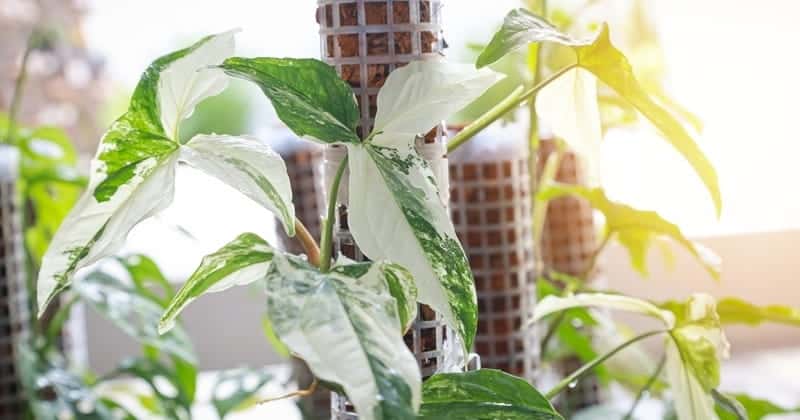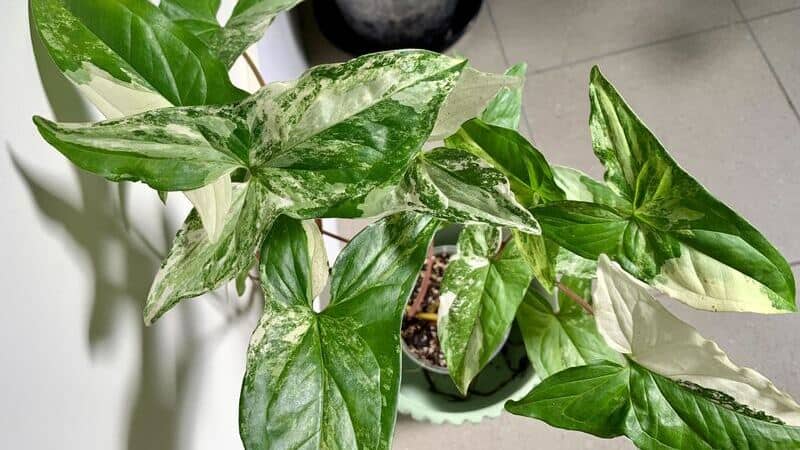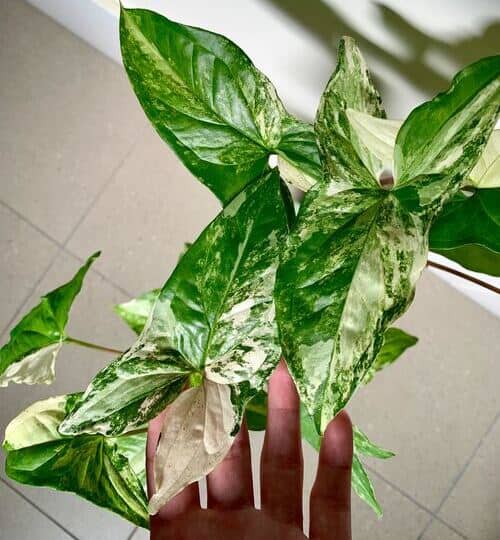If you want a classy plant that makes a statement, look no further than a variegated Syngonium. The leaves change colour as seasons and years progress, and make for a visual delight.
Syngonium varieties are easy to care for as all-terrain indoor plants. They like a warm environment, ideally between temperatures of 18–25ºC. Your Syngonium might tolerate some shade, but bright, indirect light is best to maintain variegation. It likes high humidity. In terms of watering, let the top few centimetres dry out in between sessions. It’s easy to propagate, so regular pruning is doubly beneficial!
Got a Syngonium Fantasy to care for? Whether you’ve just bought new plants or need some tips on how to care for your current plant – here’s your guide to Syngonium Fantasy care.
Syngonium Fantasy 101
The Syngonium Podophyllum Albo Variegata is a gorgeous plant. This rare Syngonium variety has stunning green and white variegation on its arrow-shaped leaves. It grows moderately slow, making it very easy to look after.
About
Syngonium Podophyllum has many names – Syngonium Fantasy, Arrowhead plant, Variegated Syngonium, and Albo Variegata. It’s easy to propagate and care for, although it requires regular pruning to keep at a manageable size.
If you let your Syngonium Podophyllum grow as a trailing vine, it can reach 1.80m in length/height. A trailing Syngonium looks fantastic in hanging baskets, while larger plants can grow up stakes and trellises.
The plant originates from Central and South America, in tropical and subtropical regions. There are about 20–30 Syngonium varieties.
Sunlight
The Syngonium Fantasy can tolerate low-light conditions, making it a perfect plant for indoor spaces. Avoid placing it under direct sunlight, which could cause leaves to burn and fade. If you want to maintain its variegation, place your Syngonium Albo Variegata under bright, indirect light.
If your plant has light green leaves, it won’t do as well in low light. Deep green leaves do better in shaded conditions.
Water
Don’t let the soil completely dry – maintain slightly moist soil in spring and summer, then slightly drier in the cooler months. A good rule is to check the top 3.0cm of soil – if it’s dry, it’s time for watering!
Avoid overwatering your plant, as this can lead to root rot. Conversely, if you under-water your plant, it could lead to yellowing, droopy leaves.
Soil
Like most plants, the Syngonium likes well-draining soil. It’s not very picky, but thrives most in slightly acidic to neutral ground with a pH of 5–7. If grown in potting soil, you can mix in some peat and perlite for more aeration.
It’s important to have good air circulation around the roots, as otherwise they could rot.
Climate
Syngoniums like humidity, so maintaining a high humidity environment will keep your plant happy and healthy. But don’t worry if you can’t – your plants will be okay in average household humidity as well.
You can boost the humidity around your plants by using pebble trays, or grouping your Syngoniums with other plants.
If you live in a place where temperatures can reach below 10ºC, know that your plant can be quite sensitive. Keep it indoors and in a warmer environment during the cold months.
Pruning
If you want a bushy plant, trim it regularly! This will encourage new growth and keep your plant in a good shape. This also means you can get cuttings to propagate!
If you don’t prune, the vines will extend and become long. This is ideal for display in hanging baskets, on top shelves, or up trellises and stakes.
Propagating Syngonium Fantasy
Growing new plants from a Syngonium Fantasy is very straightforward! Make a cutting right below a node (where the leaf reaches the vine). Trim the last few leaves to expose the nodes.
Place the cutting in a glass or container of filtered water. Make sure one or two nodes are under the surface. Change the water every few days or when it gets cloudy, and remove any leaves that are rotted.
You can place multiple cuttings in a single container so long as the roots have room to breathe. Transplant them into soil as soon as the roots start crowding in the container.
Syngonium Podophyllum Care FAQ
You may have some questions about caring for a Syngonium Fantasy. No worries – we’ve got answers.
Do I need to repot my Syngonium Fantasy?
Yes, you do! Young Syngoniums can grow fairly quickly, and could become rootbound within a year. You should transplant a young Syngonium Fantasy annually, when the pot starts inhibiting root growth.
Mature plants only need to be transplanted every 2–3 years.
Why does my Syngonium Podophyllum look different?
Your Syngonium’s variegation changes with the seasons and sunlight. This means that when it’s mature, it can look somewhat different from the original plant. Maintain its beautiful variegation by placing it in bright, indirect light.
What can damage my Syngonium Fantasy?
Common pests and diseases include spider mites, aphids, mealy bugs, and thrips. You can use a neem oil spray regularly to deal with any pests.
Meanwhile, if you notice any leaves have leaf spots or powdery mildew, trim them off immediately and wipe down the remaining foliage.
Is Syngonium Fantasy toxic?
Yes, it is toxic to both humans and pets if ingested. Keep out of reach of any curious children or dogs. We recommend not owning a Syngonium plant if you have cats, as they can reach even high places.





